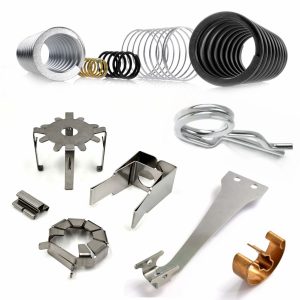 What exactly does the term “technical springs” mean? Which types of metal springs are they meant and for which force states and applications are they used? Gutekunst Federn and Gutekunst Formfedern will briefly address these questions and other properties in the following article.
What exactly does the term “technical springs” mean? Which types of metal springs are they meant and for which force states and applications are they used? Gutekunst Federn and Gutekunst Formfedern will briefly address these questions and other properties in the following article.
The term technical springs includes all metal springs that are used in technical applications. The special property of technical springs is their reversible change in shape when loaded. This is made possible by the special shape and the spring material used. Technical springs are used in almost all industries, for example in mechanical engineering, in the Electrical and Medical technology , of the Food industry , of the Air- and Space travel , and perform a variety of tasks there. Technical springs, like Shaped springs , Flat springs , Flat springs , Contact springs , Compression springs , Tension springs and Coil springs , are used as storage elements, measuring elements, vibration elements, rest elements and bearing elements.
Table of Contents
Spring technology
The basic technology of all technical springs is based on their ability potential energy when tension energy to store and convert this into kinetic energy in a controlled manner and vice versa. Below are a few examples of the force states for which technical springs are often used:
Restoring force
The spring force is used as a counterforce to return the moving mass to its previous position of rest. This restoring force is the most common application of technical springs and is used by shaped springs, flat springs, compression springs, tension springs and Leg springs provided to the same extent.
Adhesive force
In frictional connections put lock washers and spring washers Pressure and adhesive forces are ready, which counteract an unintentional loosening, mostly of screws and nuts.
Balancing force
Technical springs are often used to compensate for changes in shape, size or position of other components electrical connection g to maintain. Depending on the task, shaped springs, flat springs, contact springs, compression or torsion springs are suitable for this.
Weight force
The spring is used to distribute the load evenly between bodies. The best example is the innerspring mattress, which can handle this weight with special conical compression springs provides.
Driving force
The preload of a technical spring stores energy, which is then released when it is released and drives mobile devices. With coil springs For example, mechanical watches are driven or flexible dog leashes are rolled up.
Vibration and damping force
The technical spring deforms when kinetic energy is absorbed by forces or impacts. When the mass swings out, this kinetic energy is converted back into potential energy. Take care, for example leaf springs for safe loading from forces and impacts.
Spring development
The goal of the new development of a technical spring is to find a spring for the given application that fits perfectly, taking all circumstances into account. Function, shape and dimensions must be selected so that the technical spring optimally fulfills the required spring work. Various factors play an important role in spring development – for example, which task the technical spring has to fulfill, which spring movement is desired, how large the available installation space is and which connecting components are present. In addition, there are properties and special features from the overall construction and the conditions of use. So are often corrosion resistance , electric conductivity or to consider the most economical production possible basis of the spring construction . In general, the following requirements for spring development for technical springs must be combined:
Task and function
What is the technical spring used for (medical technology, food technology, electrical engineering, etc.) and which functions – such as state of force, force development ( spring characteristic ) and any additional functions (electrically conductive, non-magnetic, insulating, acid-resistant, etc.) – are required?
Installation situation and installation space
How is the force introduced (compression, tensile, torsional or bending stress) and what installation space is available for this?
Feather type and shape
Which spring type is suitable for the task and with which spring shape can this be implemented in the existing installation space?
Required forces and spring travel
Which spring forces are required for certain spring travel or lengths?
Operating temperature and environment
In which operating temperature and in which surroundings (Air, salt water, engine oil etc.) is the technical spring used?
Type of load and service life
Which load type is there (static constant load or dynamic load with variable loads and stroke stresses)? For what total service life should the technical spring be made?
If you do not have any further answers on the subject of technical springs or if you need a professional design with a non-binding price offer for your spring application, simply send us the requirements, a drawing or CAD data for the desired metal spring, regardless of which metal spring it is the question mark “?” in the menu Products or by email to service@federnshop.com . Or you can contact the technicians at Gutekunst Federn , Metal springs made of spring steel wire, by phone at (+49) 035 877 2270, or Gutekunst Formfedern , Metal springs made of flat material, by phone at (+49) 07445 85160.
Related Links: